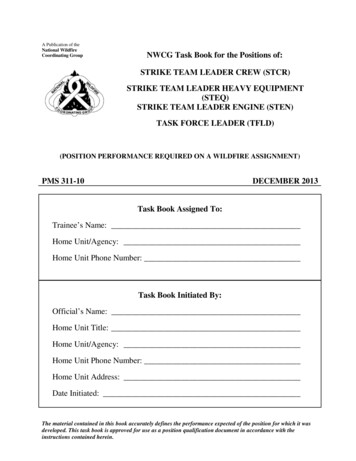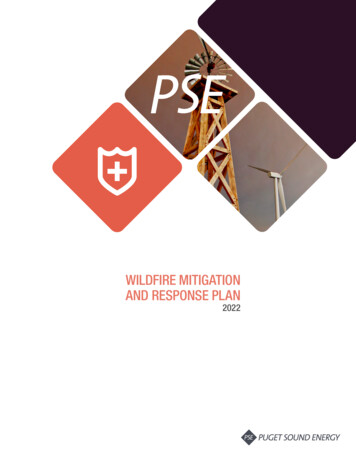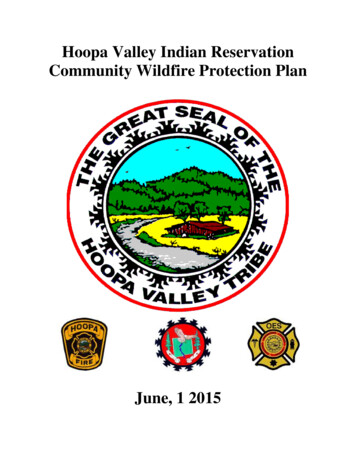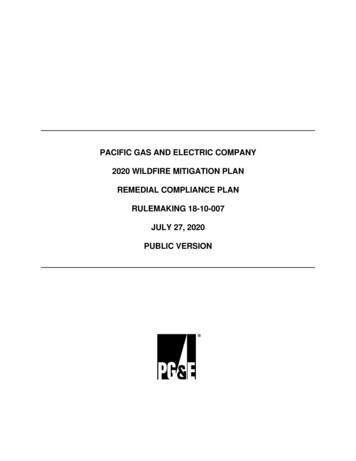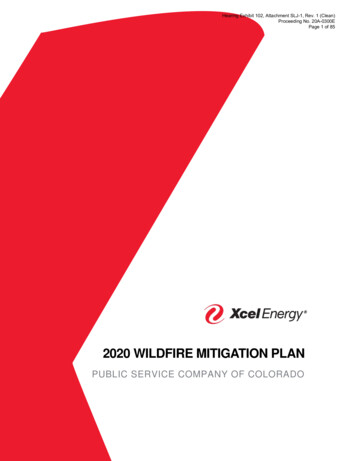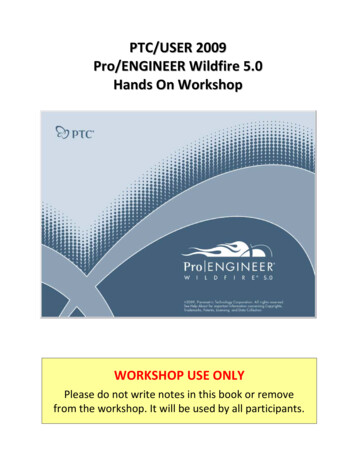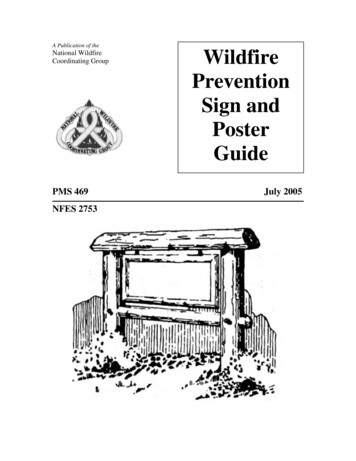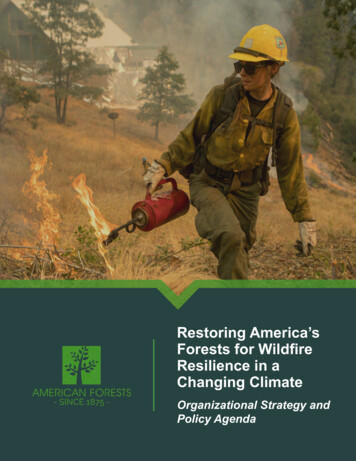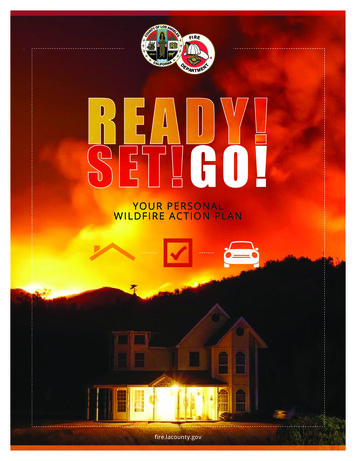
Transcription
YO UR P ERSONALW I LDF IRE AC TION P L ANfire.lacounty.gov
IN S IDEM E S SA G E F R OM F I RE CHIEFD A R YL L. OS B YDear Residents,Los Angeles County is one of the most beautiful places to live, but for those livingin “wildland urban interface areas,” it does not come without risks. With a yearround fire season and ever-growing number of wildfires, firefighters and residentsalike are now constantly on heightened alert for the threat of wildfires.The Los Angeles County Fire Department, along with our partnering agencies,stand ready to quickly respond to contain wildfires, utilizing our firefightingresources from the air and ground to help protect you and your propertyfrom wildfire.But, we can’t do this without your cooperation. Preparation and prevention go hand-in-hand. ThisReady! Set! Go! brochure was designed to provide you with critical information on creating defensiblespace around your home, retrofitting your home with fire-resistant materials, and preparing you tosafely evacuate well ahead of a wildfire. Please protect yourself, your family, and your property from adevastating wildfire by taking the time to learn about Ready! Set! Go!In Los Angeles County, wildfires will continue to be fueled by a build-up of seasonal dry vegetation anddriven by dry conditions and locally strong winds, making them extremely dangerous and challenging forfirefighters to control. Yet, many homeowners don’t consider how a wildfire could affect them, and veryfew residents have properly prepared for evacuation until it is too late.You play the most important role in protecting yourself, family, and property. Through planning andpreparation, we can all be ready for the next wildfire. I hope you find the information in this brochurehelpful as you prepare your home and family for a wildfire.READY!Defensible Space4-5Fuel Modification6-7Tour a Wildfire-Ready Home8-9SET!Create Your Own Wildfire Action Plan10Wildfire Action Plan11Assemble Your Emergency Supply Kit12Pre-Evacuation Preparation Steps12GO!Take Action Immediately When Wildfire Strikes13What to Do if You Become Trapped14Returning Home After a Wildfire14Remember the Six P’s15Additional Resources15As always, if you need additional information about preparing for a wildfire or any other natural disaster,please contact your nearest fire station or visit us at fire.lacounty.gov.Daryl L. OsbyLos Angeles County Fire ChiefCOUNTY OF LOS ANGELES BOARD OF SUPERVISORSHILDA L. SOLISJANICE HAHNhildasolis.orghahn.lacounty.govHOLLY J. MITCHELLKATHRYN .lacounty.govChair and Supervisor, First DistrictSupervisor, Second DistrictSHEILA KUEHLSupervisor, Third Districtsupervisorkuehl.com2LOS ANGELES COUNTY FIRE DEPARTMENTPreparing for a wildfire starts with three simple steps:Supervisor, Fourth DistrictSupervisor, Fifth DistrictPlease keep this plan on hand as a quick reference for helping yourfamily and property be safe in the event of a wildfire.Ready! Set! Go! Wildfire Action Plan fire.lacounty.gov3
HAZARDOUSLiving in the Wildland Urban InterfaceReady! Set! Go! begins with a house that firefighters can defend.ORNAMENTAL LANDSCAPEDefensible SpacePreventing conditions where fire can travel from adjacent fuels,through an ornamental landscape to your structure, is the keyto creating defensible space. Fire spreads through convection,conduction, radiation, or embers. Proper maintenanceof ornamental vegetation reduces ember production, firepropagation, intensity, and duration of the approaching flames.Creating and maintaining defensible space is essential for increasing your home’s chance of surviving a wildfire. It’s thebuffer homeowners are required to create between their structure and the native landscape. This space slows the spreadof wildfire and improves the safety of firefighters defending your home. Defensible space composition varies, dependingon vegetation type and topography. Three zones make up the required 200 feet of defensible space.This home provides a good example of defensible space.Defensible Space(ZONE 1 ZONE 2 ZONE 3 200 FEET)Zone 1Zone 1Extends 30 feet out from the structure Remove all dead or dying vegetation. Remove dead or dry leaves and pine needles from youryard, roof, and rain gutters. Trim trees regularly to keep branches a minimum of10 feet from other trees. Remove dead branches hanging over your roof. And,keep branches 10 feet away from your chimney. Relocate exposed woodpiles outside of Zone 1 unlessthey are completely contained in a fire-resistantenclosure.Zone 3Zone 230 FEET70 FEET100 FEETZone 2Zone 3Extends from the outer edge ofZone 1 to 100 feet from the structureExtends from the outer edge of Zone 2 to 200 feet from the structure Cut or mow annual grass down to a maximum heightof three inches.Zone 3 consists of mostly native plants appropriately thinned and spaced by 30 to 50 percent. The objective is toreduce vegetation density and overall fuel load. This slows the rate of fire spread, reducing flame lengths and fireintensity before it reaches irrigated zones or structures. Create vertical and horizontal spacing between treesand shrubs (the distance between trees should bethree times the height). Irrigation systems are not required. Vegetation consists of modified existing nativevegetation. Remove fallen leaves, needles, twigs, bark, cones, andsmall branches. However, a mulch layer may be permittedto a depth of four inches, if erosion control is an issue. Irrigation is recommended to maintain vegetationmoisture content. Remove vines and climbing plants from combustiblestructures (e.g., bougainvillea, wisteria). Remove or prune vegetation near windows (youshould be able to see out the windows). Additional ornamental shrubs and trees are generallynot recommended due to water conservation goals. As the distance from structures increases, native plantsmay be removed in reduced amounts. Existing native vegetation is modified by thinning andremoving plants constituting a high fire risk,including, but not limited to, laurel sumac, chamise,ceanothus, sage, sage brush, buckwheat, and Californiajuniper. Spacing for existing native trees or small groups of treesis 30 feet between the edge of canopies. This dependson the species, topography, and orientation on the site.HIGH-HAZARD PLANTS Create separations between trees, shrubs, and items thatcould catch fire, such as patio furniture, swing sets, etc.Note: Special attention should be given to the use and maintenance of ornamental plants known or thought to behigh-hazard plants when used in close proximity to structures. Examples include acacia, cedar, cypress, eucalyptus,Italian cypress, juniper, palms (remove all dead fronds), pine (removal within 30 feet of structures), and pampasgrass. These plantings should be properly maintained and not allowed to be in mass plantings that could transmitfire from the native growth to any structure. Irrigation is recommended to maintain vegetationmoisture content.Acacia (Shrub)LOS ANGELES COUNTY FIRE DEPARTMENT Spacing for large native shrubs or groups of nativeshrubs is 15 feet between the edge of their canopies. Remove the lower ¹/₃ of large shrubs and all dead woodto reduce fuel loads. Remove vegetation and items around and under decksthat could catch fire.4 Trees should be limbed up to at least six feet above gradeand a minimum of three times the height of underlyingplants.EucalyptusJuniperPalmPinePampas GrassReady! Set! Go! Wildfire Action Plan fire.lacounty.gov5
Fuel ModificationWhat Is Fuel Modification?Create a Defensible HomeThe Fuel Modification Plan Review Program affects new structures and developments built in fire hazard severity zones.A Fuel Modification Plan (or landscape plan) identifies defensible space zones and restricts or limits planting around structures.A home with defensible space has the greatest potential of surviving awildfire. Defensible homes are compliant with the Los Angeles County FireDepartment’s brush clearance requirements. Homes built after January 1, 1996,have been through the Fire Department’s Fuel Modification Program, wherestrict planting requirements and construction standards improve fire safety inthe high and very high fire hazard severity zones.For further information, please visit bit.ly/fuelmod or call (626) 969-5205.Fuel Modification ZonesFuel Modification Zones(ZONE A 30Ideal Fuel Modification Landscape:Limited woody plant material, highmoisture content, adequate spacing,and inorganic mulch throughout Zone A.6LOS ANGELES COUNTY FIRE DEPARTMENTZONE B ZONE C 200 FEET)10070Zone AZone BEXTENDS 30 FEET FROM THE STRUCTUREEXTENDS FROM THE OUTER EDGE OFZONE A TO 100 FEET FROM THE STRUCTUREIrrigated with slightly denser planting than Zone A. Avoidwoody plants larger than three feet in height at maturityunder tree canopies. Irrigated area consisting of low-growing, smallherbaceous plants with high-moisture contentimmediately around structures. Hedges shall not be within five feet of any structures. Occasional accents of woody shrubs or small patiotrees 10 feet from structures. Single plants and/or groups of plants are widely spaced (the distancebetween plants is three times the height).Has zone-appropriate shade trees with adequatespacing. Minimize continuous canopy coverage to reduce firetransmission. Screening plants may be used; however, continuoushedges are discouraged as this promotes accumulationof dead litter inside the live hedge and creates acontinuous fuel ladder to the structure. Cut annual grasses to three inches and remove leaflitter. Vines and climbing plants are not allowed oncombustible structures. Use rock or non-combustible mulch within five feetof structures.WILDLAND/OPEN SPACEZone CEXTENDS FROM THE OUTER EDGE OF ZONE BTO 200 FEET FROM THE STRUCTURE Thin to remove dead vegetation and preventovergrowth. Thin native species to slow the fire’s progress andreduce its intensity by decreasing availability ofcontinuous fuels. Native vegetation is thinned 30 to 50 percent inZone C.Ready! Set! Go! Wildfire Action Plan fire.lacounty.gov7
Safeguard or “Harden” Your Home1 1 ake sure your address is clearly visible from the road.MThe address needs to be a contrasting color to the surfacethat it is mounted on, so it can be seen.Chimney2 over your chimney and stovepipe outlets with a nonCflammable screen of 1/8-inch wire mesh or smaller toprevent embers from escaping and igniting a fire. ree branches must be removed within 10 feet of anyTchimney (exception: oak trees). I nstall smoke alarms on each level of your homeand adjacent to the bedrooms. Test them monthlyand change the batteries twice a year. uild or remodel with fire-resistant building materials, suchBas brick, cement, masonry, or stucco. Be sure to extend materials from foundation to roof.6Non-CombustibleFencing 7 nsure that all gates open inward and are wide enough toEaccommodate emergency equipment. rim trees and shrubs above all roads clear to the sky, withTthe exception of Oak trees which only need to be cleared toa height of 13½ (or 13.5) feet.Garage ox-in eaves with non-combustibleBmaterials to prevent accumulationof embers. ake sure to use non-combustible fencing to protect yourMhome during a wildfire.Rain Gutters creen or enclose rain gutters to preventSaccumulation of plant debris.Roof58 ave a fire extinguisher and tools, such as a shovel, rake,Hbucket, and hoe, available for fire emergencies. our roof is the most vulnerable part of your homeYbecause it can easily catch fire from windblown embers. I nstall a solid door with self-closing hinges betweenliving areas and the garage. Install weather strippingaround and under the doors to prevent ember intrusion. omes with wood shake or shingle roofs are at a higher riskHof being destroyed during a wildfire. uild your roof or re-roof with fire-resistant materials thatBinclude composition, metal, or tile. se heavy timber or non-flammable constructionUmaterial for decks and patio covers, especially withinthe first 10 feet of the home. tore all combustibles and flammable liquids away fromSignition sources. Keep the garage closed whenever possible. lock any spaces between roof decking and covering toBprevent ember intrusion. nclose the underside of balconies and decks withEfire-resistant materials to prevent embers fromblowing underneath. lear pine needles, leaves, and other debris from your roofCand gutters. Cut any tree branches within 10 feet of your roof.3Home Site and Yard eep your deck clear of combustible items, such as baskets,Kdried flower arrangements, and other debris.Driveways and Access Roads Woodproducts, such as boards, panels, or shingles, arecommon siding materials. However, they are combustibleand not good choices for fire-prone areas. Deck/Patio Cover 544 riveways should be designed to allow fire and emergencyDvehicles and equipment to reach your home (current firecode requirement is 15 feet wide). 6 nsure you have up to a 200-foot radius of defensible spaceE(cleared vegetation) around your home. If the 200-footdistance is on adjacent property, contact your local firestation for assistance in obtaining adequate clearance. ut dry weeds and grass before noon when temperaturesCare cooler to reduce the chance of sparking a fire whenusing metal tools. ccess roads should have a minimum 10-foot clearance onAeither side of the traveled section of the roadway and shouldallow for two-way traffic. eep woodpiles, propane tanks, and combustible materialsKaway from your home and other structures, such as garages,barns, and sheds (recommended 30 feet). ocked or electric gates should have a disconnect or aLlock box. nsure trees and branches are at least four feet away fromEpower lines. Notify your power company if this conditionexists; they will complete required work.8LOS ANGELES COUNTY FIRE DEPARTMENTWater Supply 10 ave multiple garden hoses that are longHenough to reach any area of your home andother structures on your property.Windows11 eat from a wildfire can cause windows to break evenHbefore the home ignites. This allows burning embersto enter and start internal fires. Single-paned and largewindows are particularly vulnerable. I nstall dual-paned windows with an exterior pane oftempered glass to reduce the chance of breakage in a fire. imit the size and number of windows in your home thatLface large areas of vegetation.Utilities Ensure that your family knows where your gas, electric,and water main shut-off controls are and how to safely shutthem down in an emergency.811Vents Ventson homes are particularly vulnerableto flying embers.9 ll vent openings should be covered withA/8-inch or smaller metal mesh. Do not usefiberglass or plastic mesh because they canmelt and burn.101 andscape with fire-resistant plants that are low-growingLwith high-moisture content. 9 eep a working fire extinguisher on hand andKtrain your family how to use it. Store in an easilyaccessible location (check expiration date regularly). 3Walls Non-CombustibleBoxed-In (Soffit) EavesTour a Wildfire-Ready HomeAddressInside2The ability of your home to survive a wildfire dependson the materials your home is constructed of andthe quality of the “defensible space” surrounding it.Windblown embers from a wildfire will find the weaklink in your home’s fire protection scheme and gain theupper hand because of a small, overlooked, or seeminglyinconsequential factor. However, there are measuresyou can take to safeguard your home from wildfire.While you may not be able to accomplish all of themeasures listed below, each will increase your home’s and possibly your family’s - safety and survival. 7 ttic vents in eaves or cornices should be baffled orAotherwise to prevent ember intrusion (mesh is notenough).Ready! Set! Go! Wildfire Action Plan fire.lacounty.gov9
Your PersonalWILDFIRE ACTION PLANDuring High Fire Danger days in your area, monitor your local media for information on wildfires and be readyto implement your plan. Hot, dry, and windy conditions create the perfect environment for a wildfire.Create Your Own Wildfire Action PlanNow that you have done everything you can to protectyour home, it’s time to prepare your family. YourWildfire Action Plan must be prepared with allmembers of your household well in advance of awildfire. Each family’s plan will be different, dependingon their situation. Once you finish your plan, practiceit regularly with your family, and post it in a safe andaccessible place for quick implementation.1IMPORTANTPHONE NUMBERSImportant Phone pply KitImportantDocumentsEVACUATIONWHEN TO GO)Phone A family communication plan that designates an out-of-areafriend or relative as a point-of-contact to act as a single source ofcommunication among family members in case of separation.WHAT TO TAKEInsurancePapersEMERGENCY CONTACTSName12WHERE TO GOSCHOOLS Maintain a list of emergency contact numbers posted near yourphone and in your Emergency Supply Kit (see page 12 in this guide).2What to TakeName()HOW TO GET THEREPhone Assemble an Emergency Supply Kit (see page 12 in this guide). Keep an extra Emergency Supply Kit in your car in case you can’tNameget to your home because of fire. a portable radio or scanner, so that you can stay updated on Have(Prepare to EvacuateWHO TO TELL (BEFORE AND AFTER))the fire.3DESTINATIONPhoneFAMILY & FRIENDS Designate an emergency meeting location, outside the fire or hazardANIMAL SHELTER area. It is critical to determine who has safely evacuated from theaffected area.Name(Name) Have several different travel routes from your home andPhonecommunity identified. Practice these often, so everyone in yourfamily is familiar in case of emergency.10LOS ANGELES COUNTY FIRE DEPARTMENT)Phone ave all of the necessary supplies and/or boarding options for Hyour pets and large animals identified and/or packed. If trailersare necessary for larger animals, have a plan that is tested andready to implement.(Name(LOS ANGELES COUNTY FIRE DEPARTMENTIF YOU HAVE AN EMERGENCY, CALL 9-1-1)PhonePublic Information Office: (323) 881-2411fire.lacounty.govReady! Set! Go! Wildfire Action Plan fire.lacounty.gov11
Assemble Your Emergency Supply KitPut together your emergency supply kit long before a wildfire or other disaster occurs, and keep it easily accessible, so youcan take it with you when you have to evacuate. Plan to be away from your home for an extended period of time. Each personshould have a readily accessible emergency supply kit. Backpacks work great for storing these items (except for food andwater) and are easy to grab. Storing food and water in a tub or chest on wheels will make it easier to transport. Keep it lightto be able to easily lift it into your vehicle.Essential SuppliesThree-day supply of non-perishable food and three gallonsof water per personMap marked with at least two evacuation routesFirst aid kitEMERGENCYKITBattery-powered radio and extra batteriesLeave early enough to avoid being caught in fire, smoke,or road congestion. Don’t wait to be told by authoritiesto leave. In an intense wildfire, they may not have timeto knock on every door. If you are advised to leave, don’thesitate!Sanitation suppliesCopies of important documents(e.g., birth certificates, passports, etc.)Family photos and other irreplaceable itemsFollow these steps as soon aspossible to get ready to GO! Review your Wildfire Action Planevacuation checklist.Your PersonalWILDFIRE ACTION PLANDuring High Fire Danger days in your area, monitor your local media for information on brush fires and beready to implement your plan. Hot, dry, and windy conditions create the perfect environment for a wildfire.Don’t forget food and water for your pets!If Time AllowsEasy-to-carry valuablesBy leaving early, you will give your family the best chanceof surviving a wildfire. You also help firefighters by keepingroads clear of congestion, enabling them to move morefreely throughout the neighborhood and do their job.When to GoChange of clothing and closed-toe shoesAn extra set of car keys, credit cards, and cashGo EarlyFlashlightPrescriptions or special medicationsExtra eyeglasses or contact lensesTA K E A C T I O N I M M E D I AT E LY W H E N W I L D F I R E S T R I K E SPersonal computer data on hard drives/flash drivesChargers for cell phones, laptops, etc.The terms “Voluntary” and “Mandatory” are used todescribe evacuation orders. However, local jurisdictionsmay use other terminology such as “Precautionary” and“Immediate Threat.” These terms are used to alert you tothe significance of the danger. All evacuation instructionsprovided by emergency personnel should be followedimmediately for your safety.1Where to GoWhen an evacuation is anticipated and if time permits, follow these checklists to give your home the best chance of surviving a wildfire:AnimalsLocate your pets and keep them nearby.Prepare large animals for transport and think about movingthem to a safe location early.InsideTurn off propane tanks. Move propane BBQ appliancesaway from structures.Connect garden hoses to outside water valves or spigots foruse by firefighters.Shut all windows and doors, leaving them unlocked.Don’t leave sprinklers on or water running.They can affect critical water pressure.Remove flammable window shades, lightweight curtains,and close metal shutters.Leave exterior lights on.Move flammable furniture to the center of the room, awayfrom windows and doors.Leave your lights on, so firefighters can see your homeunder smoky conditions.Shut off the air conditioning.Shut off the gas meter and all pilot lights.OutsideGather flammable items from the exterior of the houseand bring them inside (e.g., patio furniture, children’s toys,doormats, etc.) or place them in your pool.Put your emergency supply kit in your vehicle.Back your loaded vehicle into the driveway with alldoors and windows closed. Carry your car keys withyou.Have a ladder available in a conspicuous location forfirefighter use.Seal attic and ground vents with a non-combustible materialor commercial seals, if time permits.Monitor your property and your wildfire situation. Don’twait for an evacuation order, if you feel threatened and needto, leave.Leave for a pre-determined location. It should be a lowrisk area, such as a well-prepared neighbor or relative’shouse, a Red Cross shelter or evacuation center, motel, etc.2WHAT TO Name()EmergencySupply KitImportantDocumentsEVACUATIONWHEN TO GOPhoneWHERE TO GOSCHOOLName()HOW TO GET THEREPhoneName(Pre-Evacuation Preparation StepsIMPORTANTPHONE NUMBERSEMERGENCY CONTACTSDESTINATIONWHO TO TELL (BEFORE AND AFTER))PhoneFAMILY & FRIENDSANIMAL SHELTERName(Name)Phone()PhoneName(LOS ANGELES COUNTY FIRE DEPARTMENTIF YOU HAVE AN EMERGENCY, CALL 9-1-1)PhonePublic Information Office: (323) 881-2411www.fire.lacounty.govReady! Set! Go! Wildfire Action Plan fire.lacounty.gov9How to Get ThereHave several evacuation routes in case one route is blockedby the fire or by emergency vehicles and equipment.Choose an evacuation route away from the fire. Ensure yourEmergency Supply Kitis in your vehicle.EMERGENCYKIT Cover up to protectagainst heat andflying embers. Wearlong pants, a longsleeve shirt, heavyshoes/boots, a cap,dry bandana (for facecover), goggles, orglasses. 100% cottonis preferable. Locate your pets andtake them with you.Check on neighbors and make sure they are preparing to leave.12LOS ANGELES COUNTY FIRE DEPARTMENTReady! Set! Go! Wildfire Action Plan fire.lacounty.gov13
Remember the Six P’sPeople and PetsPapers, phone numbers,and important documentsSurvival Tips if You Become TrappedIn Your Home Stay calm and keep your family together.Call 9-1-1 and inform authorities of your location.Fill sinks and tubs for an emergency water supply.Keep doors and windows closed, but unlocked.Remove curtains from the windows.Prescriptions,vitamins, andeyeglassesTurn your interior and exterior lights on.Stay inside your home.Shelter away from outside walls.PlasticIn Your Vehicle Pictures andirreplaceable memorabilia(e.g., credit cards, ATM cards)Stay calm.and cashPark your vehicle in an area clear of vegetation.Close all vehicle windows and vents.Cover yourself with a wool or cotton blanket or jacket.Lie on the vehicle floor.Use your cell phone and call 9-1-1 to inform authorities of your location.On FootOFFICIALfacebook.com/LACoFD Stay calm. Go to an area clear of vegetation, a ditch or depression on leveltwitter.com/LACoFD Lie face down and cover up your body. Use your cell phone and call 9-1-1 to inform authorities of your , if possible.Returning Home After a WildfireDo not return home until emergency officials determineit is safe. You will receive proper notification to do so assoon as it is possible, considering safety and accessibility.When You Return Home Be alert for downed power lines and other hazards. Check propane tanks, regulators, and lines before turning gas on. Check your residence carefully for hidden embers or smoldering 4PUBLIC INFORMATION olLACOFD ntyFire1instagram.com/lafireteam14Personal computerhard drivesand flash drivesLOS ANGELES COUNTY FIRE DEPARTMENTDownload theReady! Set! Go!Wildfire Action Plan atfire.lacounty.gov/rsgor by scanning thisQR code with yoursmart phone.Ready! Set! Go! Wildfire Action Plan fire.lacounty.gov15
LOS ANGELES COUNTYFIRE DEPARTMENTPublic Information Office1320 N. Eastern AvenueLos Angeles, California 90063323-881-2411fire.lacounty.govProduced by the Communications Sectionof the Executive Support Division.Revised January 14, 2021.LOS ANGELES COUNTYFIRE DEPARTMENT FOUNDATION1320 N. Eastern Ave.Los Angeles, CA 90063323-793-FIREsupportlacountyfire.orgThe Los Angeles County Fire Department Foundationis a charitable 501(c)(3) nonprofit organization.Learn more or donate online at SupportLACountyFire.orgor donate by texting F-I-R-E-S to 44321.
Los Angeles County is one of the most beautiful places to live, but for those living . retrofitting your home with fire-resistant materials, and preparing you to safely evacuate well ahead of a wildfire. Please protect yourself, your family, and your property from a . Department's brush clearance requirements. Homes built after January 1 .

